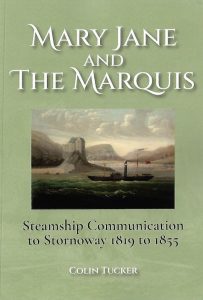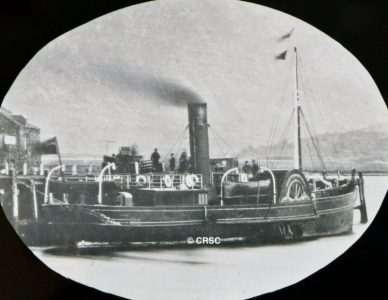Iain MacLeod welcomes Colin Tucker’s pioneering study of early 19th century travel to Stornoway, when voyages to the Outer Hebrides were far from regular or reliable.
 Colin Tucker, who has made Stornoway his home, has already done much to earn the thanks of CRSC members: he has spoken entertainingly at our meetings, written authoritatively for our magazine and contributed generously to our website.
Colin Tucker, who has made Stornoway his home, has already done much to earn the thanks of CRSC members: he has spoken entertainingly at our meetings, written authoritatively for our magazine and contributed generously to our website.
He has also written books: in 2013 he gave us Steamers to Stornoway: Ships and Shipping Services to Lewis from 1750 and five years later, for those whose interests extend to buses, he offered Mitchell’s: The Story of a Stornoway Family’s Garage and Bus Business. Now Colin has taken on another challenge, to tell the story of a long-ago spell in steamer history, the development of steamship communication with Stornoway in the early-to-mid 19th century.
As far as is known, no photographic record exists of the vessels involved, though for his new book Colin has managed to source an enjoyable selection of illustrations. This was also an age largely pre-dating the sort of systematic record-keeping which eases the task of modern research. However, access to local newspapers has in recent years become much easier thanks to the British Newspaper Archive’s online digitisation service, which has made searching for relevant titbits of news much more straightforward.
Largely gone are the days of sitting at a desk in a newspaper office or library, leafing in hope through the yellowing and brittle pages of a broadsheet newspaper. There are sometimes frustrating limitations to the BNA’s ‘search’ facility, and there are huge gaps in its coverage: the only Oban newspapers currently available to search online, for example, are dated between 1868 and 1875, and for researchers into the Clyde steamers there are no digitised Dunoon or Largs newspapers at all.
Encountering a mine of information from one source but a drought elsewhere makes it even more important for historians to avoid assuming that something did not happen simply because no report of it has yet presented itself. Having said all that, Colin has taken full advantage of the wide range of Inverness newspapers available for the period he has chosen to cover, 1819 to 1855.
With a particular emphasis on the part played by James Matheson and the boats which give the book its title, he has selected numerous advertisements and sometimes very detailed items of news, quoting extensively from them and stitching them together. In this way he has brought to life the way things were for any traveller who contemplated journeying from Glasgow to Stornoway two centuries ago.
The tale Colin spins is a lively one, populated with memorable characters – proprietors, managers, skippers, tourists, crofters, fisherfolk – and full of telling insights into the almost unbelievably arduous way of life our forebears endured. The coming of the steamship and the benevolence of some landowners certainly helped make a difference, even if only by making it easier for people to seek new lives in new lands.
Problematic questions about the Clearances, or indeed the source of the wealth which allowed James Matheson to purchase and control his holdings in Lewis, would be out of place in a book focussed so keenly on the steamship trade. So, too, would an examination of the influence over Lewis life of Matheson’s chamberlain or factor, John Munro Mackenzie, though we modern readers should be grateful to him for one thing at least: his is a vivid contemporary voice which has happily been preserved and which Colin allows to speak for itself through the extracts from his diary, which add hugely to the tale and reveal some of the inner workings of a steamship concern in 1851. Mackenzie spent six years with Matheson, later becoming lessee of the Clydesdale Distillery in Wishaw and eventually retiring, enviably, to Mull where his Mornish estate included beautiful Calgary Bay.
There were more Stornoway steamers in those four or five early decades than might have been expected, not just Mary Jane and the ‘Marquis’ of the title. It is good to be able to follow the systematically chronicled fortunes of the service as it became more regular and reliable, first and foremost enabling the efficient shipping of goods from and to the island but also easing the passage of both local people and open-mouthed visitors.
Newspaper reports of voyages in those days, particularly by visitors from afar, laid huge emphasis on the Romantic nature of the sea- and land-scapes of the western seaboard. Colin demonstrates that the appeal of these dramatic features was widespread and the strength of feeling aroused by the prospect of seeing them sometimes unreasonable. As early as July 1825 passengers were complaining bitterly to the master of the steamer United Kingdom that he had decided that landing at Staffa was impossible: many Hebridean masters down the years will know how Captain Oman must have felt.

Mary Jane, named after the wife of James Matheson, her first owner, was built in 1846 for the Glasgow-Stornoway service. Subsequently renamed Glencoe, she spent most of her 85-year career in the fleet of David MacBrayne Ltd, and is seen here at Corpach
The extracts which Colin selects also serve to remind us forcefully of the vagaries of weather and coastline which sometimes made (and make) the seafarer’s life so difficult. In our age of (perhaps too) instant communication it is startling to be reminded that the non-appearance of a steamer at the expected hour could lead to hours and days of great and widespread anxiety before reliable information (cheering or saddening) eventually arrived.
Colin modestly insists that his account is not comprehensive and that new information would be welcome. In that spirit I offer answers to two questions which I think the book leaves hanging. I am happy, of course, to be told that I have not looked carefully enough, but I did wonder why speeches were made by Lord Blantyre at the launching of the ‘Marquis’. Indeed, who was Lord Blantyre? It turns out that he was the husband of the Duke of Sutherland’s second daughter. And for that matter, why was the steamer named Marquis of Stafford? Answer: it turns out that the Marquess (as it was properly spelled) and the Duke of Sutherland were one and the same man. James Matheson (new money) clearly valued and celebrated his connection with a ducal contemporary (older money).
Those of us who enjoy sailing among the highlands and islands of Scotland’s west coast, and who cannot help wondering about the history of these beautiful places and their people, owe Colin Tucker a new debt. His careful research has filled a gap and reminded us all of just what insights into our past the newspapers of years gone by can offer.
His book gives voyagers by today’s Loch Seaforth, and many more further afield, an opportunity to reflect with thanks upon the efforts of those in the story who paved the way for our generally effortless travel to and from the Long Island.
‘Mary Jane and The Marquis: Steamship Communication to Stornoway 1819 to 1855’ by Colin Tucker, paperback 202pp. Published by Ferry Publications, £12.99.












